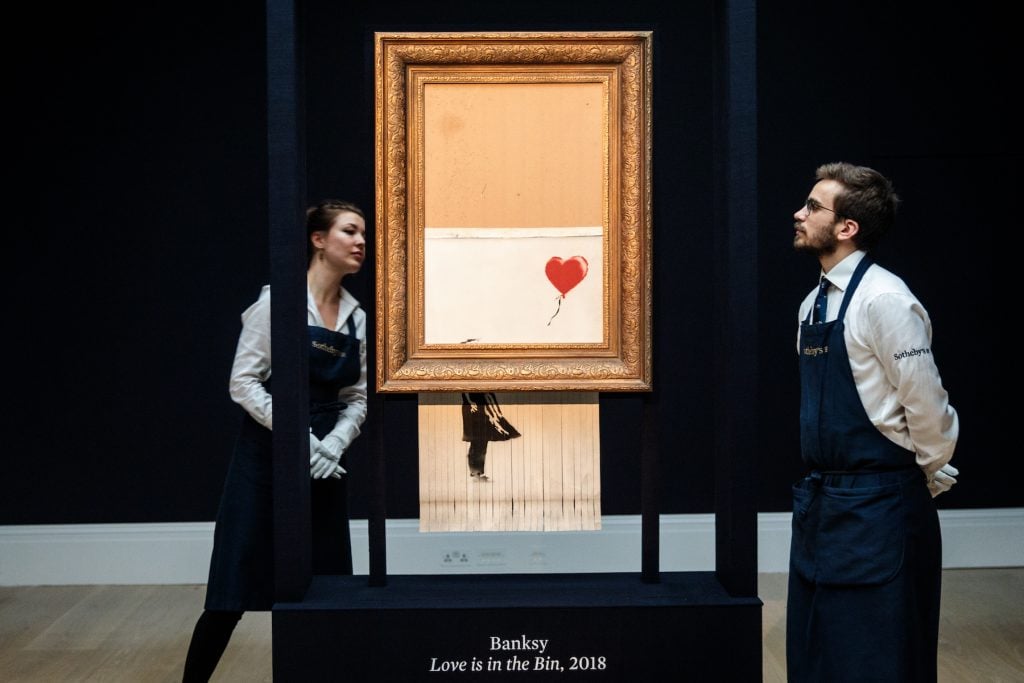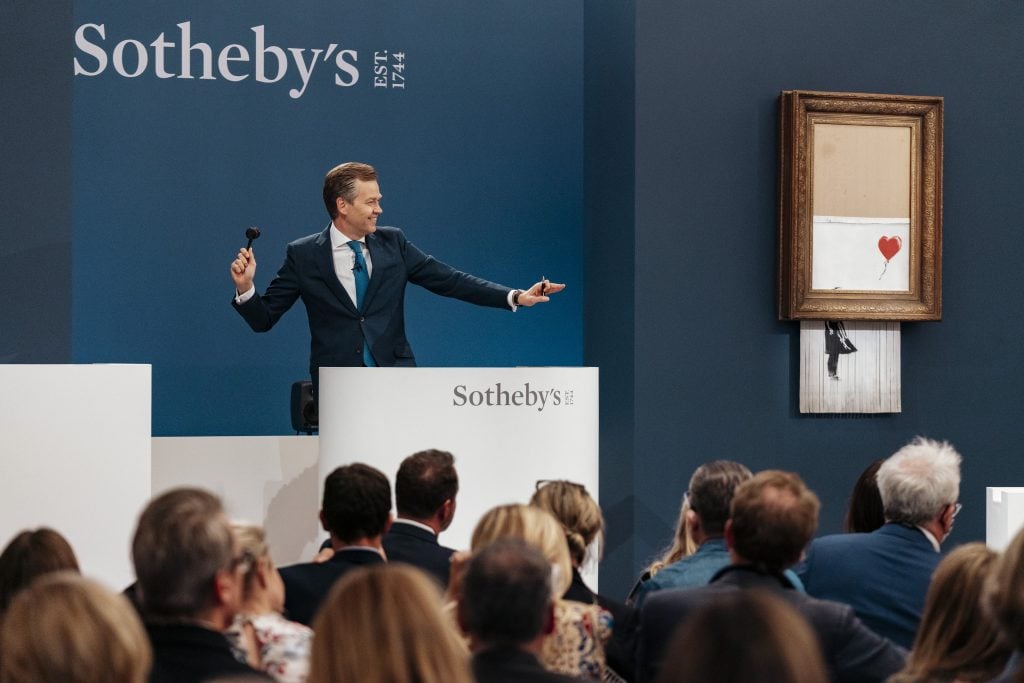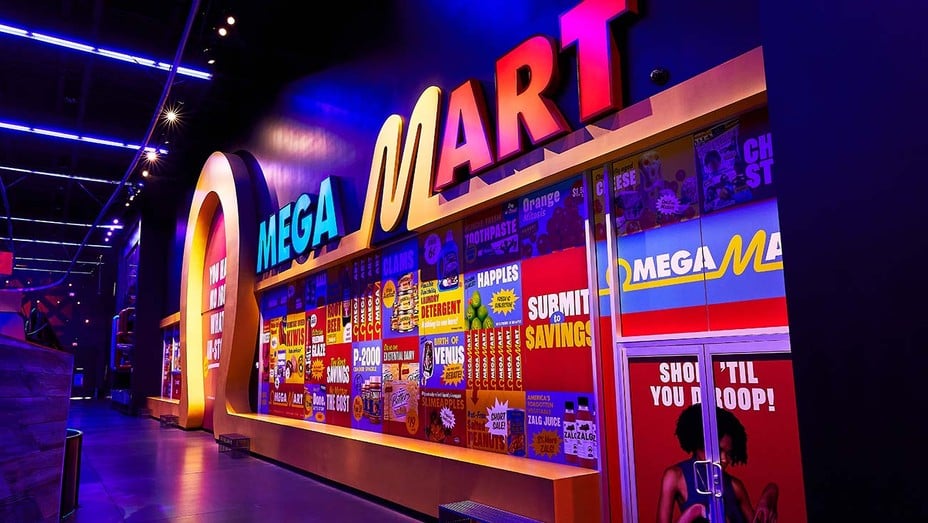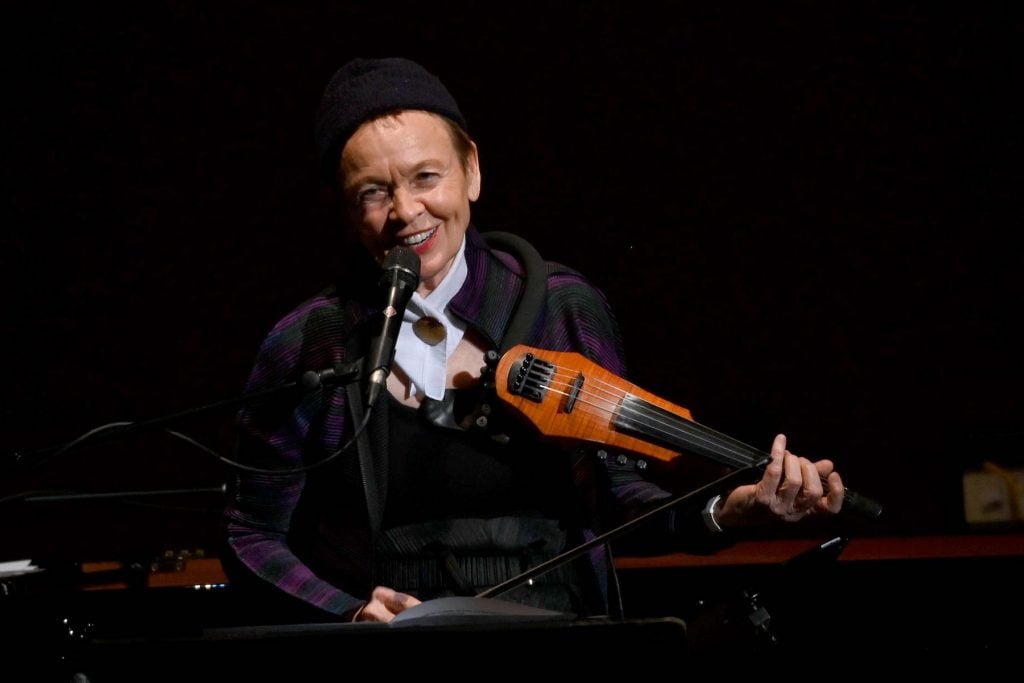Curiosities
Someone Paid $25 Mil for Banksy Leftovers? Is This the HAL 9000 of Museums? + Other Questions I Have About the Week’s Art News
Plus, is October Mist the color to cure all your woes?

Plus, is October Mist the color to cure all your woes?

Curiosities is a column where I comment on the art news of the week, sometimes about stories that were too small or strange to make the cut, sometimes just giving my thoughts on the highs and lows.
Below, some questions posed by the events of the last week…
I still maintain that Banksy’s 2018 self-destructing art stunt is the best thing that has ever happened at an art auction. Is it funny that a painting turned itself into a giant paper shredder in the middle of a sale and started eating itself? Yes, that is very funny.
However, as with most sequels, last week’s re-sale of the partly shredded painting brought with it more money, more hype, and much less fun.
The original stunt made Sotheby’s look like dopes. Quickly, however, all involved embraced the reality TV mantra that “infamous” is just a slightly longer way to say “famous,” and all was right again in the auction world.
Sold originally in 2018 as Girl With Balloon, the work was rechristened by the artist as Love Is in the Bin after it semi-self-destructed at the unexpected climax of the auction. It then went on view at a private museum in Germany. Last week, concluding its Buddhist journey of death and rebirth, it returned to the same auction floor in its new incarnation, selling for $25 million—thus achieving auction-house nirvana.

Banksy’s Love is in the Bin about to go under hammer at Sotheby’s contemporary art evening auction in London. Courtesy of Sotheby’s.
According to journalist Kelly Crow, in advance of the sale, Sotheby’s proudly proclaimed its love of the stunt by ribboning its blue Sotheby’s banner, Love Is in the Bin-style, basically doing everything but running up a big “OUR REPUTATION IS… SHREDDED!” flag. Everyone involved is so mildly titillated to have had their pants pulled down by Banksy that the spectacle now has a light masochist vibe to it.
Sadly, on Thursday, there was no sequel when the hammer came down where the painting let out a big fart sound or something. The in-frame shredder’s electrical mechanism and batteries had been removed, so essentially someone paid $25 million for the sad debris of a good prank. It’s the equivalent of auctioning off a broken version of Big Mouth Billy, the Singing Bass, or a tub of “Rare and Valuable Nickelodeon Slime From the Time Nick Jonas Got Slimed at the Kid’s Choice Awards.”
In any case, it’s worth taking a moment, amid all the post-sale back slapping, to emphasize the questions that remain unanswered from the original stunt. Here is how I imagine a conversation about it with Sotheby’s would go:
Q: Were you in on this with Banksy?
A: Of course not. We were surprised to be made into goofs—pleasantly surprised, in fact! Because it did make quite a bit of money.
Q: What about the person who consigned the painting? Were they in on it?
A: They are very happy with the whole thing. Because of the money.
Q: So… you didn’t notice the big shredder in the frame? Are you just very bad at your job?
A: Well, it’s important to remember that it only ended up being worth more money.
Q: But how can people trust that you really check anything then?
A: Of course you can trust us. I mean, it is worth more money.
Q: What if there’d been, like, a bomb in the frame? Or a dead rat? Would you have found that?
A: I can’t answer hypotheticals. The important thing is money.
Earlier this month, Las Vegas’s immersive art playground Area 15 teamed up with Blooloop to present the Blooloop Innovation Awards, honoring immersive experience design. (Blooloop, for those who don’t know, is a trade publication for “visitor attraction professionals”—and not, as its name might suggest, a new kind of toilet bowl deodorizer.)

The entrance to Meow Wolf’s Omega Mart at Area 15 in Las Vegas. Photo courtesy of Meow Wolf.
In a ceremony with a few too many awkward pauses for an industry defined by audience engagement, Area 15 C.E.O. Winston Fisher served up awards in 14 categories, including “Digital,” “Immersive,” “Interactive,” “Inclusion,” “Spectacular,” “Splash,” and “Thrills.” Notably lacking were awards that honored achievement in “Spills” and “Chills.”
Best in Show overall went to Area 15’s own Meow Wolf-designed attraction, Omega Mart, so the whole thing was kind of like Area 15 having a ceremony to give itself an award.
But the award that caught my eye came in the “Engagement” category, which went to something called Chaperone, from Dapper Labs. In essence, it is an app that allows museums to create customized device experiences for visitors. It was first deployed in a gallery at the Gilcrease Museum in Tulsa to explicate Native American artifacts, where it looks harmless enough.
But get excited, or scared, because with its Innovation Award victory, Chaperone’s creators want you to know that it is more, so much more.
“No, Chaperone is not another app. It’s so far from being just another app, we’re not calling it an app, even though at first glance, it looks like one,” they write. The interactive tour at the Gilcrease, they boast, was just the beginning: “Since this first project, Chaperone has morphed and evolved and been set-free. No longer tied to one venue Chaperone can be used at any and all venues.”
Chaperone wants to be the HAL 9000 of the museum experience, its AI taking charge of all the master controls of your museum journey via data mining, audience tracking, and then using super-intelligence to educate and pacify. It offers:
Ticketing, yes of course. Maps, directions, heatmaps. Yes. Burgers and coke. Yes. But is that really all that’s needed now that we’re living in the future? No. No it’s not, we contend. We can and we should be doing so much more with and for our audiences.
Chaperone is very smart. It knows a lot. It knows who, what, where, and when. It is also friendly. It can talk to anyone, in any language, and anything in machine language. It takes all of this data, information and knowledge and by offering high value personalized interactions with the visitors, converts it into knowledge and understanding. Understanding for the brand to learn deeply about their audiences, and understanding for the visitor to more deeply, and personally engage with the brand and whatever related subject matter they are interested in.
It would be unexpected if the origin of real-life SkyNet was not, as foretold, nuclear defense but just trying to get kids to stay still while they learn about museum stuff. But I’d be lying if I said that didn’t look like a possibility:
It’s a bold claim to say that Chaperone can do everything, for everyone, everywhere. So we will stop short by saying this; probably Chaperone can do everything, for everyone, everywhere. We’re confident because we designed it this way.
Speaking of awards, Benjamin Moore Paints announced its Color of the Year last week. I mean, we all know that the real Color of the Year is the Pantone Color of the Year. But think of the Benjamin Moore one as the Golden Globes to Pantone’s Oscars—or, because the Oscars are a mess now, maybe the New York Film Critics Awards to Pantone’s Golden Globes.
The winner? Get excited for “October Mist 1495,” a pale sage color that reminds me of hotel sheets, matcha powder, and, for some reason, scrapbooking. Benjamin Moore’s people say it “quietly anchors while encouraging creative expression through color.” Nothing encourages more creativity in art than knowing exactly which color encourages creativity, that’s for sure.
Over at Architectural Digest, color specialist Nicole Pivirotto suggests another use for October Mist: therapeutic furniture accenting. “Painting shelving in a study would be a good way to temper feelings of anxiety or burnout.”

Laurie Anderson performs on stage during the 33rd annual Tibet House benefit on February 26, 2020, in New York City. Photo by Ilya S. Savenok/Getty Images for Tibet House.
The Times has a great, moving, and fun profile of Laurie Anderson on the occasion of her much-anticipated retrospective-ish show at the Hirshhorn. Sounds like they let her go wild, which is great. But thanks to the profile we also know that, sadly, it remains a vision incomplete: “When Anderson proposed filling part of a room with stinky wet mud, the museum, citing policy, said no.”
What’s the policy, against things that are totally cool?
Let the artist have her mud! It’s Laurie frickin’ Anderson! The whole time I am at the show now, I am going to be thinking, “This should stink, but it doesn’t.”